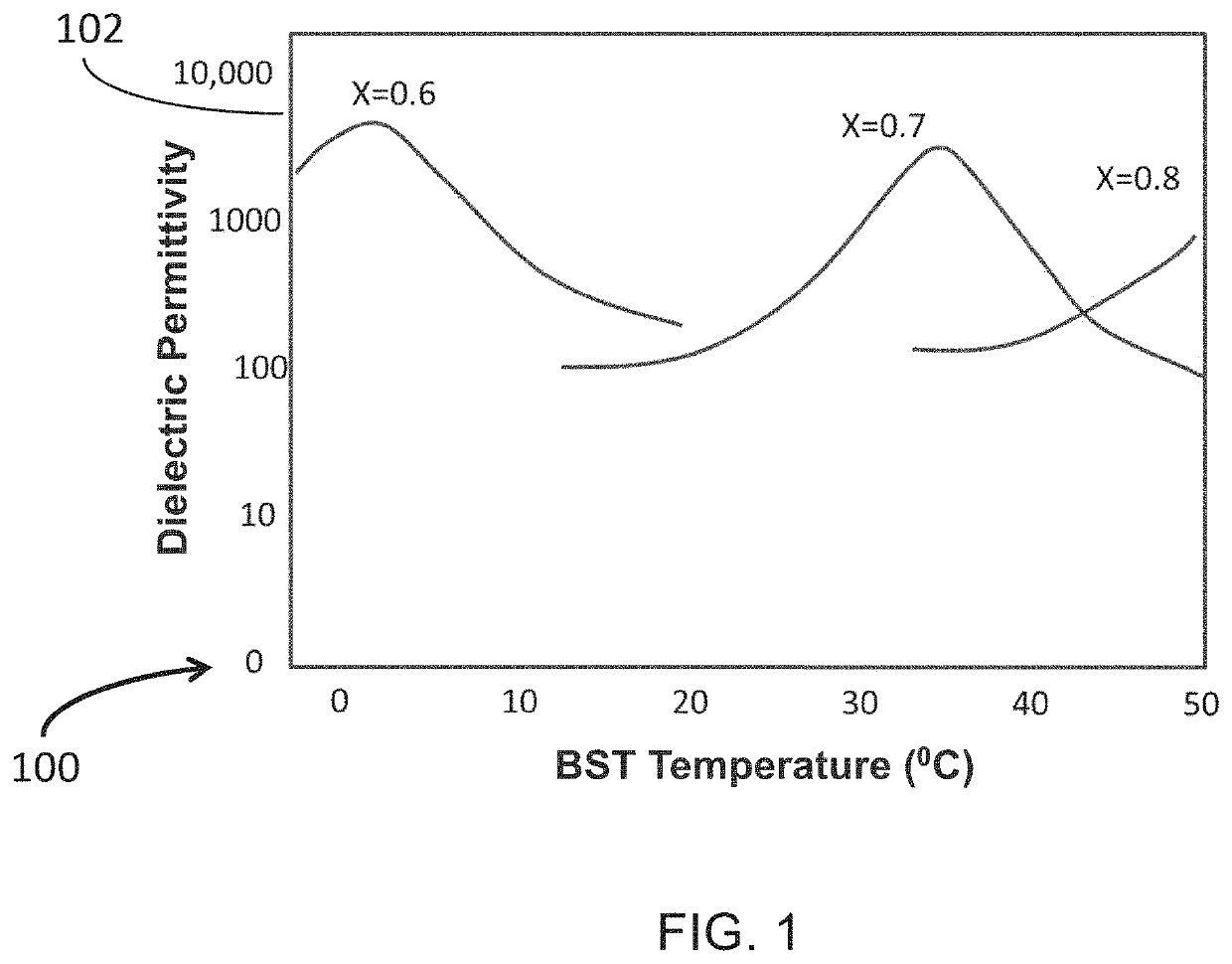Apparatus and method for tuning the permittivity of ultrahigh dielectric constant materials in an RF coil for mr imaging
a technology of dielectric constant materials and permittivity, which is applied in the direction of nmr measurement, instruments, magnetic measurement, etc., can solve the problems of low intrinsic detection sensitivity, limited sensitivity gain, and fundamental challenge of mr imaging, and achieve the effect of increasing the signal-to-noise ratio (snr)
- Summary
- Abstract
- Description
- Claims
- Application Information
AI Technical Summary
Benefits of technology
Problems solved by technology
Method used
Image
Examples
example 1
[0069]As mentioned, studies were performed to evaluate tuHDC materials or blocks(s) for understanding material properties and temperature dependence. In this study, a BST-based tuHDC ceramic (Ba0.6Sr0.4TiO3; x=0.6) block (e.g., a circular shape; 8 cm diameter and 2.1 cm thickness, e.g., block 1004 as shown in FIG. 10) was evaluated with a 17O RF surface coil (e.g., coil 1014 shown in FIG. 10). When placing the BST-based tuHDC ceramic at a center of the 17O RF surface coil, the interaction between them shifts the 17O RF coil resonant frequency ((p). FIG. 5A is a graph 502 that shows the relationship between the BST-based tuHDC block temperature and the shifting of the 17O RF coil resonance frequency from the reference operation frequency at 10.5 T of 60.6 MHz as set at room temperature. The RF coil resonant frequency was first tuned and matched to the 17O MRSI operation frequency (60.6 MHz) at the room temperature (20° C.), and was not re-tuned and re-matched when lowering the tuHDC ...
example 2
[0072]In another example, studies were performed to evaluate uHDC blocks for 31P MRS imaging studies of a phantom and human brain at 7 T. In one study, a rectangular and high dielectric loss uHDC block (see the graph 804 in FIG. 8A) was made of ferroelectric material of lead zirconate titanate (PZT: Pb(Zr, Ti)O3) ceramics, which has an ultrahigh dielectric constant value (εr≈1000) suitable for the Larmor frequency of 31P MRS(I) (120 MHz) operated at 7 T. The loss tangent value, tan δ, of this PZT-based uHDC block was high in the operation frequency range of 120-125 MHz. In another study, a curved uHDC block (13 cm width, 21.4 cm arc length, 2.3 cm thickness) was made of PZT (PBS(Zr0.5Ti0.5)TiO3) with a low tan δ value (≈0.05) and very high permittivity (εr≈1200 and insensitive to temperature change). The curved uHDC block was used to test 31P MRSI (120 MHz) at 7.0 T for phantom and human brain studies. The permittivity values of the rectangular and curved PZT-based uHDC blocks were ...
example 3
[0079]In this example, studies were performed to evaluate the BST-based tuHDC blocks for a 17O MRSI water phantom study at 10.5 T. Two circular tuHDC blocks (8 cm diameter, 2.1 cm thickness) was made using the BST-based ceramics (Ba0.6Sr0.4TiO3) with a very low loss tangent (tan δb, and εr according to Eq. [4]. The permittivity values of the two ceramics were εr≈4500 and 4700, respectively, at room temperature (20° C.). Within the temperature range of interest, i.e., above the Curies temperature (Tc≈0° C.) and below 40° C., the tuHDC ceramic is in the paraelectric state with εr≥2000 at Tb≈40° C. and εr>15000 near the Curie temperature. The BST-based tuHDC ceramic has a large tunable range in permittivity, which is highly sensitive to the BST material temperature according to Eq. [5] (also see graph 202 in FIG. 2A). The BST-based tuHDC ceramics were employed for conducting a 17O MRSI study at 10.5 T because a substantially higher permittivity value is are required owing to a relative...
PUM
 Login to View More
Login to View More Abstract
Description
Claims
Application Information
 Login to View More
Login to View More - R&D
- Intellectual Property
- Life Sciences
- Materials
- Tech Scout
- Unparalleled Data Quality
- Higher Quality Content
- 60% Fewer Hallucinations
Browse by: Latest US Patents, China's latest patents, Technical Efficacy Thesaurus, Application Domain, Technology Topic, Popular Technical Reports.
© 2025 PatSnap. All rights reserved.Legal|Privacy policy|Modern Slavery Act Transparency Statement|Sitemap|About US| Contact US: help@patsnap.com



